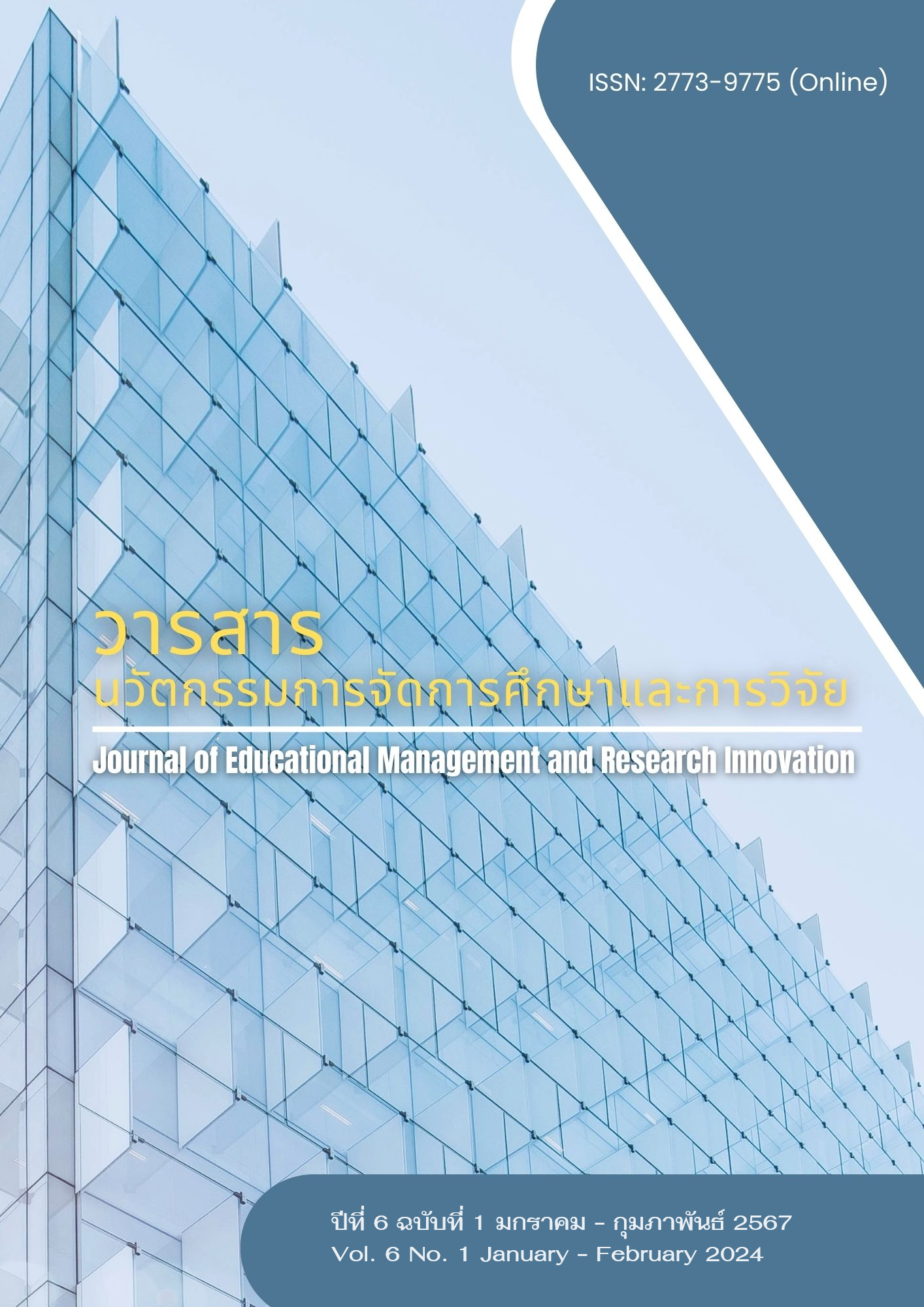คุณลักษณะของผู้บริหารสถานศึกษาในยุค Next Normal
Main Article Content
บทคัดย่อ
บทความนี้มีวัตถุประสงค์เพื่อนำเสนอการศึกษาคุณลักษณะของผู้บริหารสถานศึกษาในยุค Next Normal ซึ่งความปกติใหม่หลังวิกฤตโควิด-19 ส่งผลให้เกิดชีวิตวิถีใหม่ของมนุษย์ ซึ่งมนุษย์ต้องเปลี่ยนแปลงพฤติกรรมหลายอย่างเพื่อให้ปลอดภัยจากการติดเชื้อ ซึ่งการปรับตัวดังกล่าวจะนำไปสู่วิถีชีวิตในยุค Next Normal โดยมุ่งเน้นในเรื่องของการมีสุขภาพที่ดี และการมีสมดุลชีวิต สิ่งที่เปลี่ยนแปลงไปอย่างชัดเจน คือ การใช้เทคโนโลยีเป็น สื่อกลางในการปฏิสัมพันธ์ ในด้านการศึกษา การแพร่ระบาดของเชื้อไวรัสโควิด-19 ส่งผลกระทบต่อโอกาสในการเรียนรู้ของนักเรียนเป็นอย่างมาก และเกิดความเสี่ยงที่โรงเรียนจะกลายเป็นแหล่งการแพร่ระบาดของเชื้อไวรัสดังกล่าว และการบริหารสถานศึกษาในยุคดังกล่าวก็มีความท้าทาย ผู้บริหารจึงจะต้องมีการปรับตัว โดยบทความนี้มีวัตถุประสงค์เพื่อนําเสนอ คุณลักษณะของผู้บริหารสถานศึกษาในยุค Next normal ประกอบด้วย คุณลักษณะ 9 ประการ ผู้บริหารสถานศึกษาในยุค Next Normal ในรูปแบบ 5C-FIFA ได้แก่ 1) สร้างความเชื่อมั่น 2) แสดงพลังเชิงบวก 3) สวมหมวกนักคิดเชิงสร้างสรรค์ 4) สร้างสัมพันธ์ชุมชนแห่งการเรียนรู้ 5) สร้างบรรยากาศทางการเรียนรู้ที่หลากหลาย 6) ท้าทายกับความไม่รู้และปัญหา 7) สร้างมูลค่าเพิ่มสุดกำลัง 8) ทำงานอย่างยืดหยุ่นและเข้าใจ 9) ปรับตัวไวไม่ล้มนาน ซึ่งทั้งหมดนี้เป็นคุณลักษณะสำคัญที่จะส่งเสริมให้ผู้บริหารมีความพร้อมที่จะเข้าสู่การจัดการสถานศึกษาในยุค Next normal
Article Details

อนุญาตภายใต้เงื่อนไข Creative Commons Attribution-NonCommercial-NoDerivatives 4.0 International License.
เอกสารอ้างอิง
กาญจนา บุญภักดิ์. (2563). การจัดการเรียนรู้ยุค New Normal. วารสารครุศาสตร์อุตสาหกรรม, 19(2), 1-6.
เจริญ ภูวิจิตร. (2565). แนวทางการพัฒนาครูและบุคลากรทางการศึกษาในยุค Next Normal. ออนไลน์. สืบค้นเมื่อ20 มกราคม 2567, จาก https://www.nidtep.go.th/2017/publish/doc/202203084.pdf
ชัยยนต์ เพาพาน. (2559). แนวคิดและทฤษฎีพื้นฐานการเป็นผู้นำของผู้บริหารสถานศึกษาในศตวรรษที่ 21. วารสารบริหารการศึกษา มหาวิทยาลัยขอนแก่น, 12(1), 1-9.
ปณตนนท์ เถียรประภากุล. (2561). ภาวะผู้นำของผู้บริหารสถานศึกษาในยุคการศึกษา 4.0. Veridian E-Journal, 11(2), 1994-2013.
ปวีณา ศรีนาราง. (2560). คุณลักษณะของผู้บริหารสถานศึกษาที่ส่งผลต่อประสิทธิผลของโรงเรียน สังกัดสำนักงานเขตพื้นที่การศึกษาประถมศึกษาสมุทรสาคร. วารสารสังคมศาสตร์วิจัย, 9(2), 117-136.
นราธิป โชคชยสุนทร. (2563). ภาวะผู้นำของผู้บริหารที่ส่งผลต่อสมรรถนะการบริหารงานวิชาการของผู้บริหารสถานศึกษาในสังกัดสำนักงานเขตพื้นที่การศึกษาประถมศึกษานครพนม เขต 1. วารสารบัณฑิตศึกษามหาวิทยาลัยราชภัฏสกลนคร, 18(80), 90-95.
พระครูสังฆรักษ์ศุภณัฐ ภูริวฑฺฒโน. (2566). Now Normal to Next Normal ของพระสงฆ์ในการปฏิบัติศาสนกิจ. วารสารวิจยวิชาการ, 6(3), 325-340.
พัชราภรณ์ ดวงชื่น. (2563). การบริหารจัดการศึกษารับความปกติใหม่หลังวิกฤตโควิด-19. วารสารศิลปการจัดการ, 4(3), 783-795.
วิชัย วงษ์ใหญ่ และ มารุต พัฒผล. (2563). New normal ทางการเรียนรู้. กรุงเทพฯ: บัณฑิตวิทยาลัย มหาวิทยาลัยศรีนครินทรวิโรฒ.
ศศิรดา แพงไทย. (2559). บทบาทของผู้บริหารสถานศึกษาในศตวรรษที่ 21. วารสารวิทยาลัยบัณฑิตเอเซีย, 6(1), 1-11.
สํานักงานส่งเสริมวิสาหกิจขนาดกลางและขนาดย่อม. (2564). รายงานสถานการณ์์วิสาหกิจขนาดกลางและขนาดย่อม ปี 2564 บทที่ 7 ทิศทางเศรษฐกิจตามวิถี Next Normal. ออนไลน์. ค้นเมื่อ 29 มกราคม 2567, จาก https://www.sme.go.th/th/download.php?modulekey=215&cid=518.
สำนักงานเลขาธิการสภาการศึกษา. (2561). รายงานการศึกษาไทย พ.ศ. 2561. กรุงเทพฯ: พริกหวานกราฟฟิค.
อรรถพล อนันตวรสกุล. (2563). เปิดโมเดล “Remote Learning” ปรับการเรียนการสอนรับ COVID-19. ค้นเมื่อ 29 มกราคม 2567, จาก https://www.eef.or.th/93-2/
Bellanca, J., & Brandt, R. (2011). 21st Century Skills: Rethinking How Students Learn. Bloomington: Solution Tree.
Marquardt, M. J. (2002). Building the Learning Organization: Mastering the 5 Elements for Corporate Learning. (2nd ed.). California: Davies-Black Publishing.
Pugh, K. J. (2011). Transformative Experiences: An Investigative Construct in Spirit of Deweyan Pragmatism. Educational Psychologist, 46(2), 107–121.


